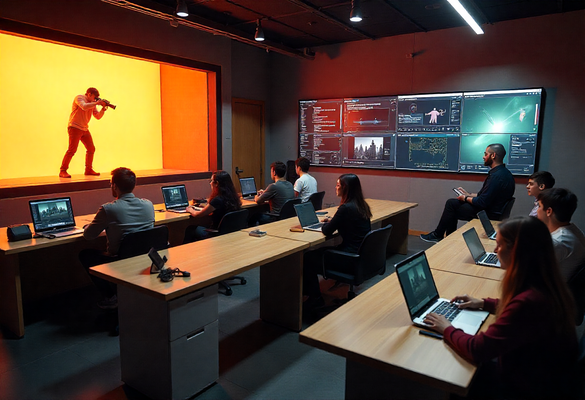CAVE Technology in Film Schools: Training Next-Generation Filmmakers

Film education stands at a crossroads between traditional storytelling methods and revolutionary digital innovation. CAVE film education represents the cutting edge of this transformation, bringing Cave Automatic Virtual Environment technology into academic institutions worldwide. Leading film schools now recognize that preparing students for modern cinema requires hands-on experience with the same immersive technologies reshaping Hollywood productions.
The integration of CAVE systems into film curricula marks a fundamental shift in how future filmmakers learn their craft. Students no longer rely solely on theoretical knowledge or limited practical exercises – they step directly into virtual environments where they can experiment with cinematic techniques, test creative concepts, and develop skills that match industry demands. This technological evolution in education ensures graduates enter the workforce with expertise in tools that define contemporary film production.
The Revolution in Film School Technology: How CAVE Systems Transform Education
Film schools across the globe face increasing pressure to provide students with relevant, industry-standard training that prepares them for professional careers in rapidly evolving entertainment industries. Traditional film education methods, while foundational, cannot adequately prepare students for virtual production techniques now standard in major studio operations.
CAVE technology bridges this educational gap by creating learning environments that mirror actual film production workflows. Students work within the same immersive systems used by major studios, gaining practical experience with virtual set design, pre-visualization techniques, and collaborative creative processes. This direct exposure to professional-grade technology ensures graduates possess marketable skills from day one of their careers.
Modern film schools implementing CAVE systems report dramatic improvements in student engagement and learning outcomes. The technology allows theoretical concepts to become tangible experiences, helping students grasp complex ideas about cinematography, lighting design, and spatial relationships that would be difficult to convey through traditional classroom methods.
The collaborative nature of CAVE environments also teaches essential teamwork skills. Students learn to work together within shared virtual spaces, communicating effectively while managing creative projects – abilities crucial for success in professional film production environments where coordination between multiple departments determines project success.

Virtual Production Training: Preparing Students for Industry Reality
Professional film production increasingly relies on virtual production techniques, making traditional film school curricula insufficient for preparing career-ready graduates. Students need direct experience with the same technologies they will encounter in professional environments, requiring educational institutions to invest in cutting-edge equipment and training programs.
CAVE systems provide students with authentic virtual production training that mirrors actual studio workflows. They learn to operate within immersive environments, manipulate virtual cameras, adjust digital lighting setups, and coordinate complex scenes – all skills essential for modern film production careers. This hands-on training ensures students understand both creative and technical aspects of virtual production.
The learning curve for virtual production can be steep, but CAVE environments provide safe spaces for experimentation and skill development. Students can make mistakes, test different approaches, and refine their techniques without the pressure and costs associated with traditional film sets. This freedom to experiment leads to more confident, capable graduates.
Film programs incorporating virtual production training also benefit from industry partnerships. Studios and production companies actively seek graduates with relevant technical skills, creating employment opportunities for students and strengthening relationships between educational institutions and professional organizations.
Digital Filmmaking Courses: Curriculum Innovation for Modern Cinema
Contemporary digital filmmaking courses must balance traditional storytelling principles with emerging technological capabilities. CAVE technology enables film schools to create comprehensive programs that address both creative and technical aspects of modern cinema production.
Course curricula built around CAVE systems typically include modules on virtual cinematography, immersive storytelling techniques, collaborative creative processes, and digital asset management. Students learn to think beyond traditional filmmaking constraints, developing skills in creating and manipulating virtual environments that enhance narrative possibilities.
The integration of CAVE technology also allows for interdisciplinary learning opportunities. Film students can collaborate with computer science, game design, and digital arts programs, creating well-rounded educational experiences that reflect the collaborative nature of modern entertainment production.
Assessment methods in CAVE-integrated programs often focus on practical project completion rather than theoretical examination. Students demonstrate their learning through completed virtual productions, allowing instructors to evaluate both creative vision and technical execution in realistic production contexts.
Immersive Filmmaking Education: Beyond Traditional Classroom Learning
Traditional film education relies heavily on theoretical instruction supplemented by limited practical exercises. Immersive filmmaking education using CAVE technology transforms this approach by making practical application the primary learning method.
Students working within CAVE environments develop intuitive spatial awareness crucial for effective cinematography and direction. They learn to think three-dimensionally about scene composition, character blocking, and camera movement in ways that traditional 2D planning methods cannot provide.
The immersive nature of CAVE learning also helps students develop critical problem-solving skills. When technical or creative challenges arise within virtual environments, students must find solutions in real-time, building confidence and adaptability essential for professional film production careers.
Faculty members teaching in CAVE-equipped programs often report that students grasp complex concepts more quickly and retain knowledge more effectively than in traditional classroom settings. The engaging, interactive nature of immersive learning appeals to diverse learning styles and maintains student interest throughout extended learning sessions.

Building Industry Partnerships Through Advanced Film School Technology
Film schools investing in CAVE technology often find that their advanced capabilities attract industry attention and partnership opportunities. Production companies recognize the value of graduates trained on professional-grade equipment and frequently collaborate with educational institutions to develop talent pipelines.
These partnerships benefit both students and industry professionals. Students gain access to real-world projects, mentorship opportunities, and potential employment connections, while companies can identify and recruit talented individuals before they enter the competitive job market.
Many film schools with CAVE systems also serve as testing grounds for new virtual production techniques and technologies. This research collaboration provides students with exposure to cutting-edge developments while contributing to industry advancement.
The reputation benefits of offering advanced technology training also help film schools attract higher-quality applicants and faculty members, creating positive feedback loops that enhance overall program quality and industry recognition.
Measuring Success: Student Outcomes and Career Preparation
Film schools implementing CAVE technology typically track various metrics to assess program effectiveness and student success. Employment rates, starting salaries, and career advancement patterns provide quantitative measures of educational value.
Graduates from CAVE-integrated programs often report feeling better prepared for professional challenges than peers from traditional programs. They enter the workforce with practical experience using industry-standard technologies and confidence in their ability to adapt to new tools and techniques.
The collaborative skills developed through CAVE-based learning also prove valuable in professional environments. Graduates demonstrate strong teamwork abilities and communication skills essential for success in complex film production environments.
Long-term career tracking indicates that students with virtual production training often advance more quickly in their careers and command higher salaries than those with traditional film education backgrounds, validating the investment in advanced educational technologies.
Conclusion
CAVE film education represents a transformative approach to preparing future filmmakers for rapidly evolving industry demands. By integrating immersive virtual environments into educational curricula, film schools provide students with practical experience using professional-grade technologies while maintaining focus on fundamental storytelling principles. This balance between innovation and tradition ensures graduates possess both creative vision and technical expertise necessary for successful careers in modern cinema.
The investment in CAVE technology yields benefits extending beyond individual student success. Educational institutions enhance their reputations, build valuable industry partnerships, and contribute to advancing virtual production techniques. As the film industry continues evolving toward virtual production methods, schools providing relevant training will play crucial roles in developing skilled professionals capable of creating tomorrow's cinematic experiences.
Film schools considering CAVE technology integration should recognize this investment as essential rather than optional. The question is not whether virtual production will become standard practice, but how quickly educational institutions can adapt to prepare students for this reality. Early adopters will establish competitive advantages that benefit their programs, students, and the broader film industry for years to come.

Frequently Asked Questions (FAQs)
Q: What exactly is CAVE film education and how does it differ from traditional film school programs?
A: CAVE film education uses Cave Automatic Virtual Environment technology to create immersive learning experiences where students work within room-sized virtual environments. Unlike traditional programs that rely primarily on theoretical instruction and limited practical exercises, CAVE education allows students to step directly into virtual film sets, manipulate 3D environments, and collaborate on projects using the same technologies employed by major studios.
Q: Which film schools currently offer CAVE technology programs and virtual production training?
A: Several leading institutions have integrated CAVE systems into their curricula, including major film schools in California, New York, and internationally. However, the availability of these programs continues expanding as more schools recognize the importance of virtual production training. Prospective students should contact schools directly to inquire about their specific CAVE technology offerings and virtual production training programs.
Q: What career opportunities are available for students trained in CAVE technology and virtual production?
A: Graduates with CAVE technology training can pursue careers as virtual production supervisors, pre-visualization artists, virtual cinematographers, immersive experience designers, and technical directors at major studios. Many also find opportunities in emerging fields like virtual reality entertainment, augmented reality production, and interactive media development.
Q: How much does it cost for film schools to implement CAVE technology, and does this affect tuition rates?
A: CAVE system installation costs vary significantly based on size, complexity, and features, typically ranging from hundreds of thousands to several million dollars. While this investment may influence program costs, many schools offset expenses through industry partnerships, grants, and the premium students pay for access to cutting-edge technology training that enhances career prospects.
Q: Can students without technical backgrounds succeed in CAVE-based film programs?
A: Yes, CAVE technology is designed to be user-friendly, and successful programs provide comprehensive training starting from basic concepts. Students primarily need creative vision and willingness to learn rather than extensive technical backgrounds. The immersive nature of CAVE learning often makes complex concepts easier to grasp than traditional technical training methods.
Q: How do employers view graduates from CAVE technology film programs compared to traditional film school graduates?
A: Industry employers increasingly prefer candidates with virtual production experience, as these skills are immediately applicable to modern film production workflows. Graduates from CAVE programs often have competitive advantages in hiring processes and may command higher starting salaries due to their specialized training in high-demand technical areas.
Q: What specific skills do students develop through CAVE film education that they wouldn't get in traditional programs?
A: Students develop spatial awareness for 3D environments, collaborative virtual production workflows, real-time problem-solving in immersive settings, virtual camera operation, digital lighting techniques, and experience with professional-grade virtual production software. They also gain confidence working with emerging technologies and adapting to new tools as the industry evolves.




